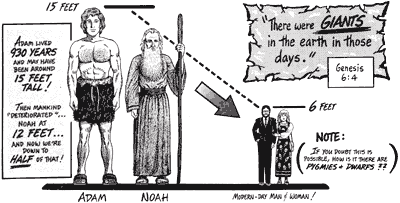“If Thou Doest Well, Thou Shalt Be Accepted”
Moses 5–7; (Genesis 4–6)
Links to the reading in the SAB: Genesis 4, Genesis 5, Genesis 6
LDS manual: here
Background
Okay, so for this lesson, we’re kind of taking a deep breath before we move on to the Flood, which is going to be a really full-on lesson. But this one sets up Cain (evil murdering skeptic) against Enoch (righteous city builder who mysteriously disappears). It’s the kind of lesson where you look at the manual, and you think, how am I going to get an interesting lesson out of that? Which is too bad, because there’s actually some interesting stuff here if we do some digging. Ready?
Main points for this lesson
It’s bad to have a skeptical attitude about God
From the real lesson manual:
Adam and Eve hoped their son Cain would follow the Lord as they did. But Cain “hearkened not” to his parents and the Lord and asked, “Who is the Lord that I should know him?” (Moses 5:16). What does this question show about Cain’s attitude toward God?
It shows that he had a healthy sense of skepticism. If you must worship someone, you should ask what they’re like, and find out what you’re getting into. But apparently the God of the Bible demands uncritical worship. That makes more sense when we find out more about his murders later on in the Old Testament; this is not the kind of being you’d worship out of admiration, though perhaps out of fear.
Beliefs about Cain
Cain is supposed to have committed the first murder when he killed his brother Abel. It’s charmingly retold with Legos in The Brick Testament.
Cain is still alive
Cain, as a mythic evil dude, has naturally inspired a lot of folklore. In the Mormon imagination, he’s become something like Bigfoot. An early apostle, David Patten, claimed to have seen him.
“As I was riding along the road on my mule I suddenly noticed a very strange personage walking beside me. He walked along beside me for about two miles. His head was about even with my shoulders as I sat in my saddle. He wore no clothing, but was covered with hair … I asked him where he dwelt and he replied that he had no home, that he was a wanderer in the earth and traveled to and fro. He said he was a very miserable creature, that he had earnestly sought death during his sojourn upon the earth, but that he could not die, and his mission was to destroy the souls of men. About the time he expressed himself thus, I rebuked him in the name of the Lord Jesus Christ and by virtue of the Holy Priesthood, and commanded him to go hence, and he immediately departed out of my sight.”
Other more modern Cain stories are detailed here, some as late as 1998. Come on, folks, there must be some more recent ones.
Also: journal article on this topic.
Ask: What can we learn about the story of Cain?
Answer: We humans seem to like building myths about big hairy guys that don’t exist.
The whole Cain story reminds me of anomalous big cats (ABCs). Even in places where big cats aren’t native, people seem to have grown these stories of ABCs roaming around. There’s the Nottingham lion, the Fen Tiger, the Lincolnshire Lynx, and scores of others. People claim to have seen them — and yet there’s never a body, no scat, and no clear photographic evidence, even with camera phones in everyone’s pockets. It’s one of the things about human brains: we sometimes see patterns where none exist, especially if we’re expecting to see them.
This is just as true for religious experience as it is for big cats or Bigfoots. Think what happens in the LDS discussions: missionaries prime the subjects to have a subjective “spiritual experience”, and they read a long list of feelings that someone might have. The appearance of any of those feelings will then be taken as evidence that a magical spirit being is confirming whatever the missionaries are saying. It’s hokey, but as suggestible as our brains are, it’s not surprising that it works well enough and often enough to keep the LDS Church in new members.
Ask: Are stories about Cain kind of like the opposite of Three Nephite stories?
Answer: Yeah, kinda. Next question.
Ask: How did Cain survive the flood?
Answer: Oh, that? He managed to survive by clinging onto the Ark, like a big hairy barnacle.
But a lot more on the Flood next week.
What’s the deal with people living 800 years?
The Book of Moses (as well as Genesis) gives a list of improbable lifespans, including Adam (930 years), Seth (912 years), and Enos (905 years). What’s the deal?
Well, this one is fairly straightforward: it’s a longevity myth. People used to make kings’ ages up.
“My favourite king was so awesome, he ruled for 10,000 years!”
“Oh, yeah? Well my favourite king was twice as awesome, and he reigned for 20,000 years!”
Read selections from Wikipedia’s page on longevity myths. Here are some good ones:
The Sumerian king Alalngar was supposed to have ruled for 36,000 years
The Persian emperor Zahhak apparently ruled for 1000 years
The Taoist saint Peng Zu lived for 800 years
And there are more examples from Hinduism, Buddhism, and Islam.
It’s not just people in antiquity who believe this stuff; it seems some New Agers today believe in the existence of Babaji, who is centuries old.
Longevity myths are another recurring theme in human belief and hero worship.
Activity for people trapped in real Gospel Doctrine classes: Tell the class about other longevity myths. Time how long it takes for them to commit the special pleading fallacy (“but that’s different!”).
The “seed of Cain” were black.
The Church’s statement on ‘Race and the Priesthood‘ is something of a landmark. Thankfully, it repudiates racism among its members.
Today, the Church disavows the theories advanced in the past that black skin is a sign of divine disfavor or curse…. Church leaders today unequivocally condemn all racism, past and present, in any form.
It also lists a few things members have believed in the past. Here’s one:
According to one view, which had been promulgated in the United States from at least the 1730s, blacks descended from the same lineage as the biblical Cain, who slew his brother Abel. Those who accepted this view believed that God’s “curse” on Cain was the mark of a dark skin.
Ask: Where might Latter-day Saints have gotten this idea?
Read: Moses 7:22
22 And Enoch also beheld the residue of the people which were the sons of Adam; and they were a mixture of all the seed of Adam save it was the seed of Cain, for the seed of Cain were black, and had not place among them.
So the Book of Moses, one of the Standard Works, promulgates the idea that people of colour are descended from Cain. And because they “had not place among them”, it might have provided support for segregation.
The LDS Church has been busy trying to clean up its record and get some distance from its worst folk doctrines. But one of the most surprising things I’ve found out since taking on this blog is that the source of these ‘folk doctrines’ is actually the Standard Works themselves. It’s all in there.
In other words, if they’re throwing things under the bus, they’re going to need a bigger bus.
Additional ideas for study
Sons of God, daughters of men
Read: Genesis 6:1–4
There were giants in the earth in those days; and also after that, when the sons of God came in unto the daughters of men, and they bare children to them, the same became mighty men which were of old, men of renown.
In some religious traditions, the ‘sons of God‘ are supposed to be angels that went to earth and had sex with women, who subsequently gave birth to giants. If you doubt this is possible, how is it there are pygmies and dwarfs?
Yup — this is a real creationist cartoon showing a 15-foot-tall Adam. (Humans can’t get that big; if they did, they’d be very weak and slow. If you were twice as tall, you’d have eight times the mass, but only four times the strength.)
But in Mormon scripture? Joseph Smith wrote the ‘sons of God’ into the narrative as normal people. This is one of the great missed opportunities in scripture. He should have written giants. It wouldn’t have been the most implausible thing he came up with.
Read: Moses 8:21 for Smith’s normal boring explanation of this scripture.
Ask: How crap is that? Could have been freaking giants, man.


13 February 2014 at 1:59 am
The Might Be Giants
http://www.thelmagazine.com/TheMeasure/archives/2009/09/17/they-might-be-giants-teach-children-about-atheism
13 February 2014 at 2:24 am
Moses 7 also presents our class with a good opportunity to discuss divine psychology. Let me suggest that a close reading shows evidence of psychopathy.
In Moses 7:28, 29 Enoch witnesses God weeping over his creation for his kids not getting along and not "choosing" him.
"And it came to pass that the God of heaven looked upon the residue of the people, and he wept … And Enoch said unto the Lord: How is it that thou canst weep, seeing thou art holy, and from all eternity to all eternity?"
O.K. At this point you might be thinking, "How touching. God is revealing himself as a sensitive and emotionally vulnerable loving god.”
Well, not so fast. Read on.
See how quickly and violently he transitions from weeping to lashing out with a "fire" of "indignation", “hot displeasure”, and “fierce anger” (Moses 7:34). And consider how this leads to his cursing an entire people with black skin (7:8, 7:12, 7:22), sending a genocidal flood (7:38), building a post-mortal prison equipped with "chains of darkness" (7:57), and thereafter covering the earth with a veil of darkness (Moses 7:61)
Whoa! Seems those tears were tears of narcissistic rage.
And to top it off, this isn't some heavy redacted OT account stripped of its "plain and precious parts." No sir. This is the first hand account of god delivered straight from a bona fide latter-day prophet!